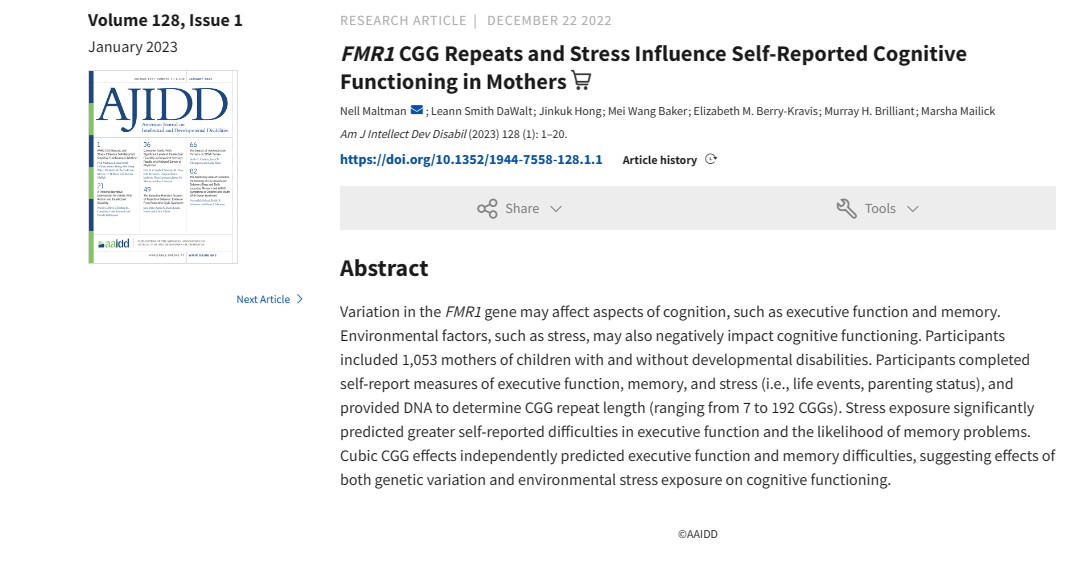By Anna DeSonia
Authors: Sneha Shah, Kevin J. Sharp, Sithara Raju Ponny, Jonathan Lee, Jonathan K. Watts, Elizabeth Berry- Kravis, and Joel D. Richter
Summary:
One of the most exciting advancements being done in clinical research today is antisense oligonucleotide (ASO) therapy. ASOs are tiny, chemically created pieces of RNA (or DNA) that bind to targeted molecules of RNA in the cells in our bodies. RNA, a nucleic acid structurally similar to DNA, is found in all living cells. The primary function of RNA is to create proteins.
People with FXS are unable to produce a very important protein called FMRP (Fragile X Messenger RibonucleoProtein) because of the excessive CGG repeats found in their FMR1 (Fragile X Messenger Ribonucleoprotein 1) gene. The main function of the FMR1 gene is to make the protein FMRP, which is needed for brain development. In people with FXS, the structure of the FMR1 gene causes the gene to turn off, or inhibit, its function to create FMRP; therefore, brain development is affected.
When ASOs bind to their RNA targets, they can modulate, or control, certain gene expressions. Through these modulations, ASOs can target the underlying causes of inherited diseases for which other drugs cannot be designed. Thus, researchers are currently exploring how ASOs can target specific areas on the FMR1 gene in a variety of ways to turn on the gene to create the missing FMRP protein.
In this study, researchers guessed that an identified abnormal RNA sequence (called RNA mis-splicing) might be widespread in human FXS patient tissues. To test this, blood samples from 29 males with FXS and 13 males without FXS of similar ages were collected. Researchers isolated and analyzed the RNA sequences found within the white blood cells from these samples. Additionally, the researchers examined publicly available RNA-sequencing data from postmortem brain tissues from individuals with FXS, the Fragile X premutation, and typically developing individuals.
This study revealed a variety of important results that support the value of ASO therapy for FXS. Much to the researchers’ surprise, analysis of the samples revealed that FMR1 RNA was found in 21 of 29 FXS white blood cell samples and in 5 of 10 FXS postmortem brain samples. These findings raised the intriguing possibility that ASO treatment may have the ability to restore FMRP levels by targeting FMR1 RNA.
Why this matters:
Overall, the study results suggest a possible therapeutic treatment to restore FMRP in individuals with FXS. These findings also indicate that abnormal RNA sequencing events found in white blood cells could serve as powerful biomarkers for FXS. This means that, through blood sampling, researchers could one day determine the “best” treatment options based on an individual’s genetic makeup, or at least be able to eliminate treatments that would not work. This is important because the treatment of FXS will begin to become more and more individualized, tackling FXS more intentionally from all available angles.
Next steps:
What does the future of gene therapy look like for the larger FXS community? Gene therapy, at a time when technology is advancing by the minute, is certainly the way of the future. With continued developments in gene therapy, gene reactivation, and protein replacement, we may – one day – be able to target and treat the root causes of FXS, instead of relying on treating its symptoms.
It’s important to remember that gene therapy is still new in comparison to other therapies. Although we are eager to get a treatment at the genetic level, we want the science and research being done in labs now to take the time to ensure that when gene therapies are ready for the FXS, they arere safe and effective for people with FXS.
For ASOs to reach their targets on the cellular level, they need to pass through many areas within the body. In order fast-track and get the ASOs to their targets most directly, the therapy needs to be delivered via injection into the spinal cord. In most cases, this requires anesthesia, as the procedure is painful and extremely delicate.
While research continues to be done outside of humans, FXS experts are taking this time as an opportunity to get better with modeling basic science (animal) studies so there’s higher predictability in human trials. We need the animal models to be more predictive of the human models to pave the way for a smooth transition to human studies, when we are ready.
According to FXS experts, the future is bright, we just need to hang tight!
Acknowledgements:
The brain tissues analyzed were a gift from Dr. Veronica Martinez-Cerdeno’s laboratory at UC Davis. Dr. Ozkan Aydemir helped with some of the bioinformatic analysis and Feng Wang (J.K.W lab) provided reagents and input for the ASO experiments. Funding was provided by FRAXA, Simons Foundation for Autism Research Initiative, NIH, University of Massachusetts Chan Medical School, and University of Massachusetts Office of Innovation and Business Development.
FOR MORE DETAILS VISIT:
The full publication, “Antisense oligonucleotide rescue of CGG expansion–dependent FMR1 mis-splicing in fragile X syndrome restores FMRP” in Proceedings of the National Academy of Sciences (PNAS).
about

Hilary Rosselot
Hilary joined the NFXF team in 2019. Prior to joining the NFXF team, she worked at the Cincinnati Fragile X Research and Treatment Center for over five years. She has experience as a clinical research coordinator across many types of clinical trials and served as the clinical research manager for the Cincinnati program. She earned a bachelor’s degree in psychology, a master’s, and is a SOCRA certified clinical research professional (CCRP). She enjoys time with family and friends, a great book, a strong cup of coffee and, of course, a good laugh!
learn more
Antisense Oligonucleotide (ASO) therapy being explored in Fragile X syndrome! | NFXF
Learn more about ASO therapy for FXS.
Survey: Developing a Caregiver-Reported Survey in Neurodevelopmental Disorders: The Neurodevelopmental Disorder-Health Index (NDD-HI)
The Center of Health and Technology’s (CheT) Outcomes Division is conducting is conducting a survey to learn about the most prevalent and impactful symptoms of FXS that the individual experiences, as reported by the caregiver.
FMR1 CGG Repeats and Stress Influence Self-Reported Cognitive Functioning in Mothers
Researchers at the University of Wisconsin looked at the relationship and influence of FMR1 CGG repeats and stress on self-reported cognitive functioning in mothers.



